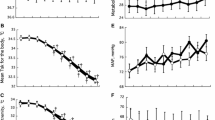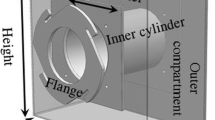Summary
Forearm and calf blood flow were measured using a mercury-in-silastic gauge during immersion of one foot in water at 4° C. The subjects were asked to assess the level of pain on a scale 0-10. The effects of one session of repeated immersions on the vascular response in the calf, forearm and on subjective pain sensation were studied. In 6 of the 14 subjects vasodilatation was elicited in both forearm and calf during the first immersion. During the first session the vasodilatation diminished, while subjective pain sensation remained at the level of 7 on the scale. In 4 subjects vasoconstriction in both calf and forearm occurred during the first immersion. During repeated immersions forearm vasoconstriction subsided, while in the calf it remained at the same level. The level of the subjective pain sensation diminished from 7.5 to 5 in 1 subject. Repeated immersions in six to ten daily sessions led to reduction of vasodilatation in calf and forearm while there was a small change in the pain sensation, i.e. reduction from the level of 6.9 to 5.7 (P < 0.01). In subjects in whom vasoconstriction in forearm and calf was observed no clear trend in vascular responses was observed during the repeated daily sessions while the pain sensation in 1 subject was reduced from 6 to 4.8. In 3 subjects the change of vascular responses was different in the forearm and calf. After complete habituation of the vasodilatation in the forearm and calf at the end of the ten daily sessions, re-tests were carried out every 7 days to see whether the vasodilatation would reappear. The vasodilatation recovered, but the time required for partial recovery in forearm or calf varied from individual to individual. The shortest time for partial recovery was 7 days, the longest more than 70 days. In all subjects but 1, the subjective pain sensation returned to its initial value or even exceeded it. In 1 subject the pain remained suppressed during the last re-test. In some subjects the changes in the vascular response in the calf and forearm did not develop in parallel. The subjective pain sensation was not reflected in vascular changes. It is concluded that the vascular response in the calf and forearm and the subjective pain sensation elicited by a noxious stimulus have independent central neural control.
Similar content being viewed by others
References
Abrahams VC, Hilton SM, Zbrozyna A (1969) Active muscle vasodilatation produced by stimulation of the brain stem: its sig-nificance in the defence reaction. J Physiol (Lond) 154:491–513
Abrahams VC, Hilton SM, Zbrożyna A (1964) The role of active muscle vasodilatation in the alerting stage of the defence reactions. J Physiol (Lond) 171:189–202
Anderson EA, Wallin BG, Mark AL (1987) Dissociation of sympathetic nerve activity to arm and leg during mental stress. Hypertension 9 [Suppl 3]:144–119
Bohme P, Ngai SH, Uvnas B, Wallenberg LR (1967) Circulatory and behavioural effects on electrical stimulation of the sympathetic vasodilator areas in the hypothalamus and the mesencephalon in unanaesthetized dogs. Acta Physiol Scand 70:334–346
Brod J, Fencl V, Hejl Z, Jirka J (1959) Circulatory changes underlying blood pressure elevation during acute emotional stress (mental arithmetic) in normotensive and hypertensive subjects. Clin Sci 18:269–279
Caraffa-Braga E, Granata L, Pinotti O (1973) Changes in blood flow distribution during acute emotional stress in dogs. Pfüg-ers Arch 339:203–216
Chery-Croze S (1983) Relationship between noxious cold stimuli and the magnitude of pain sensation in man. Pain 15:265–269
Clarke RSJ, Ginsburg J, Hellon RF (1958) Use of the strain gauge plethysmograph in assessing the effect of certain drugs on the blood flow through the skin and muscle of the human forearm. J Physiol (Lond) 140:318–326
Forsyth RP (1970) Hypothalamic control of the distribution of cardiac output in the unanaesthetized Rhesus Monkey. Circ Res 26:783–794
Forsyth RP (1972) Sympathetic nervous system control of distribution of cardiac output in unanaesthetised monkeys. Fed Proc 31:1240–1244
Hilton SM (1965) Hypothalamic control of the cardiovascular responses in fear and rage. In: The scientific basis of medicine annual reviews. Althone Press, London, pp 217–238
Johns EJ, Marriott J, Marshall JM (1989)_Vascular responses evoked in the human hand by the cold pressor test and by mental arithmetic. J Physiol (Lond) 413:23P
Longhurst J, Capone RJ, Mason DT, Zelis R (1974) Comparison of blood flow measured by plethysmograph and flowmeter during steady state forearm exercise. Circulation 49:535–540
Lovick TA (1987) Cardiovascular control from neurones in the ventrolateral medulla. In: Taylor EW (ed) Neurobiology of the cardiorespiratory system. Manchester University Press, Manchester, pp 199–208
Lovick TA (1989) Effect of 5-HT in the ventrolateral medulla on the pressor response and analgesia evoked by stimulation of the dorsal periaqueductal grey matter in anaesthetized rats. J Physiol (Lond)
Martin J, Sutherland CJ, Zbrożyna A (1976) Habituation and conditioning of the defence reaction and their cardiovascular components in cats and dogs. Pflügers Arch 365:37–47
Reis JD, Moorhead D, Wotten GF (1969) Differential regulation of blood flow to red and white muscle in sleep and defence behaviour. Am J Physiol 217:541–546
Roberts DH, Tsao Y, Breckenridge AM (1986) The reproducibility of limb blood flow measurements in human volunteers at rest and after exercise by using mercury-in-silastic strain gauge plethysmography under standardised conditions. Clin Sci 70:635–638
Rusch NJ, Shepherd JT, Webb RC, Vanhoutte PM (1981) Different behaviour of the resistance vessels of the human calf and forearm during contrallateral isometric exercise, mental stress and abnormal respiratory movements. Circ Res 48 [Suppl l]:118–130
Westwood DM, Zbrozyna AW (1989) Short- and long-term changes in vasodilatation in forearm and calf to repeated ‘cold pressor test’ in man. J Physiol (Lond) 414:40P
Whitney RJ (1953) The measurement of volume changes in human limbs. J Physiol (Lond) 121:1–27
Zbrożyna AW (1976) Renal vasoconstriction in naturally elicited fear and its habituation in baboons. Cardiovasc Res 10:295–300
Zbrożyna AW (1983) Habituation of the threatening response in cats and kittens. Acta Neurobiol Exp 43:183–192
Zbrożyna AW (1987) Habituation of cardiovascular responses. In: Taylor EW (ed) The neurobiology of the cardiorespiratory system. Manchester University Press, Manchester, pp 241–260
Zbrożyna AW, Krebbel F (1985) Habituation of the cold pressor response in normo- and hypertensive human subjects. Eur J Appl Physiol 54:136–144
Zbrożyna AW, Westwood DM (1988a) Habituation of vasodilatation in the calf elicited by repeated sensory stimulation. Eur J Appl Physiol 58:284–290
Zbrożyna AW, Westwood DM (1988b) Vascular changes in forearm and calf during sleep in man. Cardiovasc Res 22:666–673
Author information
Authors and Affiliations
Rights and permissions
About this article
Cite this article
Zbr\.ozyna, A., Westwood, D. Habituation and recovery of vascular responses in calf and forearm and of the level of pain sensation during the cold pressor test in man. Eur J Appl Physiol 61, 106–111 (1990). https://doi.org/10.1007/BF00236702
Accepted:
Issue Date:
DOI: https://doi.org/10.1007/BF00236702




